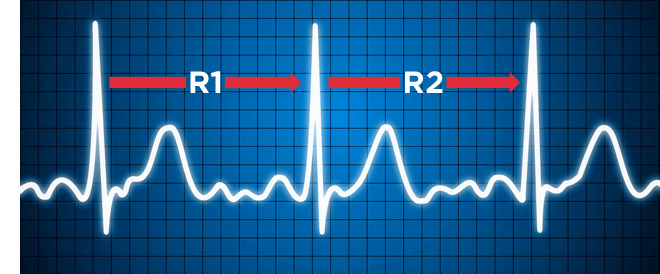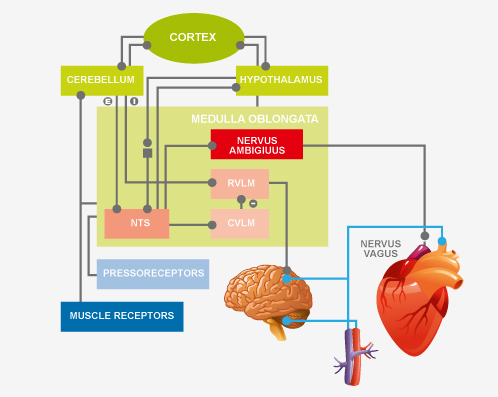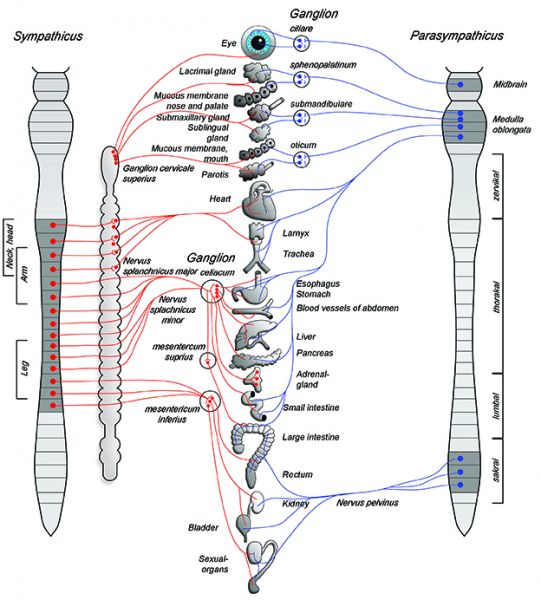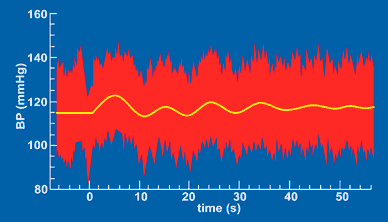Details
HRV - HEART RATE VARIABILITY
Terms for Heart Rate Variability (HRV)
There are a number of special terms for the analysis of the the autonomic nervous system. They are reflecting the underlying analytical method:
- Heart rhythm variability (HRV)
- Cycle length variability (CLV)
- Heart rate variability (HRV)
- RR variability (RRV)

The measurement is based on a technically flawless electrocardiogram that allows for clean and noise-free recording and processing of the individual R spikes. There are so called short-term measurements lasting 5-10 minutes and long-term measurements recorded over a 24 hour period. The scientific standards for HRV measurements/ANS Analyses were precisely defined by an expert commission in 1996. Based on these standards the ANS Analysis was included as a basic diagnostic procedure in the evidence-based German Disease Management Guidelines. The sequence of the intervals can be analyzed by using various mathematical and statistical methods. Here we differentiate between the following:
- Time-domain parameters
- Frequenzy-domain parameters
- Non-linear parameters e.g. DFA - Alpha1

Besides the central nervous system (CNS), the autonomic nervous system (ANS) is the most important neuronal control unit in the organism. Its primary function is to adapt the body's internal environment to external and internal stress factors (stimuli) and to maintain a stable equilibrium within the organism.The peripheral ANS is integrated in a complex system. It is not only connected to the brain stem, but also to the hypothalamus and other parts within the CNS.

The Autonomic Nervous System (ANS) With Sympathetic and Parasympathetic Nervous System
The peripheral part of the ANS essentially consists of the sympathetic and parasympathetic nervous systems. The sympathetic nervous system arises from the thoracic medulla and from the upper three segments of the lumbar spine and is therefore also called the thoracolumbal system. The parasympathetic nervous system arises from the brain stem and from the sacral spine and is therefore also called the craniosacral system.

Normal Values for Heart Rate Variability (HRV)
The sinu-atrial node is located on the inside of the rear wall of the right atrium. The impulses it generates are transmitted via the muscle cells to the atrioventricular node (AV node) and from there to the ventricles. The sinu-atrial node is the fastest and thus the primary pacemaker of the heart, with an intrinsic natural frequency of 80 to 120 beats per minute.



Modulation of Heart Rate by the Sympathetic and Parasympathetic Nervous Systems
The heart muscle is innervated by both sympathetic and parasympathetic components. The sympathetic nervous system exerts a rate-raising (positive chronotropic) effect, while the parasympathetic system exerts a rate-lowering (negative chronotropic) effect. A heart rate lower than the intrinsic excitation frequency of the sinoatrial node (80-120) indicates that the parasympathetic system is dominant; if higher, the sympathetic is dominant.

Baroreflex Integration
The signals from the baroreceptors reach the nucleus tractus solitarii (NTS) in the brainstem. From there the signals make their way to the nucleus ambiguus and to the rostral and caudal ventrolateral medulla, each of which send excitatory and inhibitory pulses to the heart and blood vessels in order to control arterial blood pressure.


RSA - Respiratory Sinus Arrhythmia
The dependence of the heart rate on respiration is known as respiratory sinus arrhythmia (RSA):There is an increase in the heart rate during inspirationThere is a decrease in the heart rate during expirationThe RSA is above all communicated by the changing activity of the vagus nerve.
Influences on the respiration-dependent heart rate variability:Pulmonary, vascular and cardiac stretch receptorsRespiratory centers in the brain stemDifferent baroreflex sensitivity in the respective phases of the respiratory cycleDue to an inspiratory vagal inhibition, fluctuations in the heart rate result at the same frequency as respiration. The inspiratory inhibition is primarily caused by the influence of the medullar respiratory center on the medullar cardiovascular center. In addition, peripheral reflexes are responsible due to hemodynamic changes and thoracic stretch receptors.

The resonance phenomenon describes the superpositioning of what in this case are biological oscillations. The physiological respiratory sinus arrhythmia describes a frequency range of approximately 0.3 Hz. Rhythmic breathing at a frequency of 6 breaths per minute causes this frequency to shift to the range of around 0.1 Hz, the same range in which, for example, the base frequency of baroreflex integration is found. This induces a change to the HRV that can be depicted directly in the analysis.Clearly seen in the rhythmogram in the left chart: HRV during "normal" breathing from left to center of rhythmogram, then HRV with controlled rhythmic respirationOver the long term, this respiratory modulation works to strengthen baroreflex control and improve parasympathetic activity.

HRV is an abbreviation for Heart Rate Variabilty.
During the HRV or ANS Analysis the time distances from one to the other heartbeat (RR-intervals) are measured in milliseconds
What does ANS mean?
ANS is an abbreviation for Autonomic Nervous System. Via the HRV analysis it is possible to measure the functional state of the autonomic nervous system (ANS), of the sympathetic and parasympathetic nervous system. That is why the HRV analysis is also called ANS Analysis.
What significance does an HRV / ANS Analysis have as a short-time measurement?
The short-time measurement is as significant as a long-term measurement. The data is validated and correlates with those from the long-term measurement. This has been proven by many studies. Since August 2011, the short-time HRV measurement is part of the German Disease Management Guidelines.
The difference is that the short-time measurement (5-10 minutes) is simpler, faster and more practicable as the long-term measurement. It is very important in the long-term measurement that the patient keeps an account of his activities. Additionally, in the long-term measurement there are increased artifacts, which have to be manually filtered out. Consequently, the evaluation takes way more time.
It must be pointed out that the ANS Analysis measures the regulation of the autonomic nervous system. Regulation means the adaption of the body by the autonomic nervous system to changing situations. This is why fluctuations of the parasympathetic and sympathetic nervous system cannot be ruled out as they are completely physiological. In the clinic, there should be some standard conditions:
- the patient should rest for approx. 10 minutes prior to the measurement (similar to taking the blood pressure).
- during the measurement, the patient should sit or lie and not move too much.
- the patient should be left alone during the measurement.
If these standard conditions are followed, the ANS Analysis is very meaningful as the body should activate the parasympathetic nervous system in a resting state.
The healthier the organism, the greater are the fluctuations from measurement to measurement as the body can regulate very well and therefore adapt very fast to changing conditions.
If someone has a blocked regulation, the ANS Analysis will show this result in the morning, during the day, in the evening and even under changing conditions. With the integrated guided respiration in the ANS Analysis Professional, it can be checked how apparent this blocked regulation is and how fast the parasympathetic nervous system can get back to the normal range.
Which parameters are important and relevant for the daily use in the clinic?
First of all, we should ask the questions : ”How many parameters does the autonomic nervous system have?” It consists of the sympathetic and parasympathetic nervous system and therefore these two parameters are the most important ones in practice.
The ANS Analysis includes the following: rhythmogram, histogram, scatter plot, sympathetic nervous system (SI), parasympathetic nervous system (RMSSD), hear rate, standard deviation (SDNN) and the Alpha 1 value indicating the quality of the regulation. More information, formulas and charts can easily become too much and confuse the therapist and the patient.
The spectral analysis does not offer any additional benefits for the clinic. Moreover, it leads to more confusion as many of the spectral analysis parameters are not meant for the short-time measurement.
What is the main statement of the HRV measurement / ANS Analysis?
- How does the autonomic nervous system (ANS) deal with stimuli and respond to them at rest?
- Is the regulation very good, good, impaired, highly impaired or already blocked?
- What effects does the therapy have on the ANS?
Can you make special diagnoses via the ANS Analysis?
No. You can only evauluate the regulatory capacity of the ANS. In case of massive regulatory disorders, you should perform further differential diagnostic examinations. You cannot say in which organ system you will notice the bad regulation first as this varies and also depends on the family anamnesis.
Is the ANS Analysis reproducible?
Yes. The measurement is performed at rest. To use the ANS Analysis for therapy monitoring, you should create standard conditions (similar to taking blood pressure). Therefore, you can see if someone’s regulation is good or bad. The base regulation does not change too much depending on the time of the day, so that you have a good regulation in the morning and an impaired one at night. Slight fluctuations are completely normal as we a working with regulatory diagnostics and not with rigid parameters. Regulation means to react to constant stimuli.
What does regulation mean?
Definition: regulation is the constant and situational adaption of all bodily functions by the autonomic nervous system (ANS). Every second, the body has to adjust according to different stimuli and react reasonably. Whether eating, running, discussing, sleeping, writing a letter etc… every minute of the day, the ANS of the human is adapting to the most different conditions and therefore there is a constant regulation of the individual systems.
What are the measurement conditions?
The patient being measured should have rested for a while prior to the measurement (similar to taking blood pressure). The measurement is taking place at rest while sitting. Because the main question is today: is the parasympathetic nervous system able to fulfill its function in a calm situation or is the sympathetic nervous system overactive?
No stress factors should be created. The measured patient should not move too much, not talk and just sit relaxed. During the 5-10 minute HRV measurment, the patient should be left alone.
How long does an ANS Analysis take?
The ANS Analysis records 520 heartbeats. The measurement time varies depending on the pulse. With a pulse of 100, the measurement takes approx. 5 minutes and with a pulse of 50 approx. 10 minutes. On average the measurement takes 7 minutes.
How exact does the ANS Analysis measure?
The measurement resolution is 1ms. The chest strap transmits the RR intervals to the iPad via Bluetooth. The data is saved and evaluated automatically on the iPad.
What is the maximum distance between the sender (chest strap) and the receiver (iPad)?
The range is approx. 5-10 meters. That is why the iPad should be in the same room as the patient. Due to the minimal need of space of the ipad, that is usually no problem.
How often should the ANS Analysis be performed?
One or two measurements per year as prophylaxis are recommended to recognize a regulatory disorder at an early stage. For therapy monitoring, the ANS Analysis should be performed more often to make sure the therapies have the desired effects. It could make sense to make up to three measurements in one month. Example: 1. measurement for initial value, 2. measurement with guided respiration, 3. measurement after 30 days of respiration therapy.
How do I interpret measuring results with a highly impaired regulation if there are no symptoms or discomfort?
Quite often, stress is the reason for the results: stress in relationships, conflicts in families, permant issues with parents or children, pressure at work or unemployment. Here, you have to clarify the causes and explain the patient what effects the stress has on the body and what that means in the long run.
A long-term highly impaired regulation is the base for future diseases. That is why the ANS Analysis is the perfect prevention diagnostics.
You should always consider the family anamnesis though to rule out potential dispositions of cardiological diseases. Otherwise, you can perform an exercise ECG to rule out further underlying diseases.
Is there a criterion for exclusion for an HRV measurement / ANS Analysis?
Yes.
Patients with atrial fibrillation / absolute arrhythmia do not have to be measured as the base for the HRV evaluation is a stable sinus rhythm. The measuring results of those patients would be falsified positively. Often, cardiac arrhythmia is identified first by the ANS Analysis being very striking in the recording.
Patients with a permanent regulating pacemaker do not have to be measured as the mathematical results do not have any meaning and significance. In this case, the pacemaker takes over the function of the autonomic nervous system. Therefore, no conclusions can be made for the regulation of the ANS.
Additional Information
| manufacturer | No |
|---|---|
| Tax Class | Momspliktige varer 25% |
This is the replacement of Upsell Products
